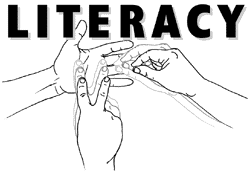

| Vol.3, No.2 | Spring 1998 |
 Literacy and Deafness: A Challenge for the Millenium Jamie C. MacDougall |
|
The volume of research that has been directed to the problem of reading and literacy in normally hearing individuals has increased significantly during the past decade. While the complex processes that underlie reading ability are not yet fully understood, some facts are now clear. In alphabetical languages such as English or French it appears that sound plays an extremely important role. We learn language first when we are very young through our ears and our first communication is through speech and hearing. It is only later, at ages 4 to 6, that we map visual symbols (the alphabet) to the complex string of sounds that we have been using constantly for 3 to 4 years. The deaf child has no, or very limited, access to the speech of others and the speech of the deaf child is seriously impaired because of the lack of ability to hear sound. Deaf children learn their ABC’s in a silent world. They see and recognize words but they have never heard them spoken. Also, and perhaps more importantly, they have not had the experience of hearing connected language so that grammar and syntax are also very difficult for them. An important point to consider in the context of deafness and literacy is the impact of the educational system on the deaf child. Educators and other professionals are bitterly divided on whether or not to concentrate exclusively on oral (speech and hearing) means of communication or whether sign language has a role to play. People who hold to the exclusive oral point of view maintain that it is imperative for deaf children to become as normal as possible through development of their speech and use of their residual hearing. Their claim is that it is a ‘hearing world’ and that if the deaf person is to progress he or she must learn to communicate in the way of the majority. Also they point to the intimate connection between speech and hearing in the process of reading itself. Those who favour the addition of sign language feel that in most instances speech and hearing are woefully inadequate for unambiguous communication to take place. There is also a growing feeling in the deaf community that the Deaf form a culture in society with a distinct language (American Sign Language - ASL) that must be recognized by all those who are involved with deaf persons. Deaf Canadians have been very active in promoting this point of view recently and all indications are that their view will prevail. ASL has been intensively studied over the past twenty-five years and all evidence confirms that this is a legitimate human language system that follows the same general developmental patterns as spoken language. It has already gained widespread currency in post-secondary programs and in adult training programs especially in the context of the Bilingual/Bicultural (BI/BI) approach to education. The challenge now is twofold: to carry out needed pure and applied research on the determinants of reading ability in deaf children and adults, and to develop programs at all levels that implement the most modern approaches to literacy in deaf people. The National Literacy Secretariat has identified two priority areas for literacy programs in Canada as a whole: family and workplace literacy. These are the very areas that are crucial for the field of deafness as well. It is well known that it is in the earliest years when the foundations for reading and writing are established. This is true for both deaf and hearing children. The family then becomes the incubator of reading skills in children and this is particularly the case with families who have deaf children. Although the challenges are substantial, there are reasons for optimism in this situation. On the research front, researchers both in and outside the field of deafness are achieving new insights about all aspects of linguistic and cognitive development as it relates to literacy. Many of these studies are in the area of sign language and its connection to the spoken word. Other developments in the area of spoken language, and assistive devices, in the opinion of some researchers, hold equal promise. In terms of practical hands on programs, again there are encouraging developments. Virtually every province has some form of adult literacy program available - some are just starting, and others such as project GOLD in Ontario are in an advanced state. Programs for Francophone deaf persons in Quebec have just been established and there is activity in Ontario in the Francophone sector as well. Programs are also developed in Nova Scotia, Manitoba and Alberta to mention but a few. Another ray of hope is provided by the application of emerging communications technology. Well known assistive devices such as the TTY (telephone device for the deaf) and CC (closed captioning on television) all contribute to literacy. Equally exciting for the future is the use of video-conferencing and distance education techniques for instruction as well as interpreting. But many problems remain. Funding is always an issue. Lack of qualified teachers, interpreters and other support personnel is also a chronic problem in many areas of the country. There is a need for standardized curriculum and increased communication between service providers. Everyone also recognizes the importance of direct involvement of the deaf community in programs but often the resources are not available to ensure this important element. Finally, if real progress is to be achieved, creative partnerships will have to emerge. Deafness is by its nature an isolating condition and many professionals and others in the field have added to this problem through the professional bickering, and by not meeting their obligations to educate the public about the realities of deafness. If we want to integrate deaf persons into the workplace meaningful, long-term partnerships with the private sector will have to be established. The issue of literacy will be central to this process. Modern methods of communication involving the internet and other new telecommunication technologies can be expected to play a large role in this process. |
 |
Jamie C. MacDougall is President of the Canadian Deafness Research and Training Institute based in Montreal and is a faculty member of the Department of psychology at McGill University. |
| Next Page |
|
The free Adobe(R) Acrobat(R) Reader allows you to view, navigate, and print PDF files across all major computing platforms. To download Acrobat(R) Reader click on the button. |
| ARCHIVE |